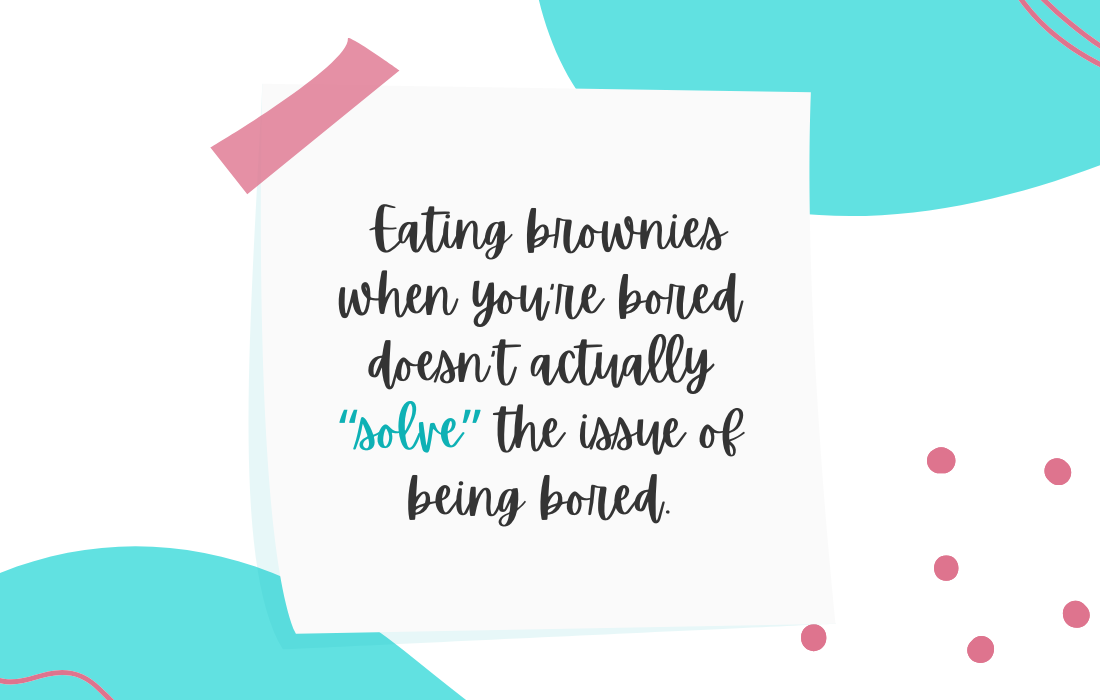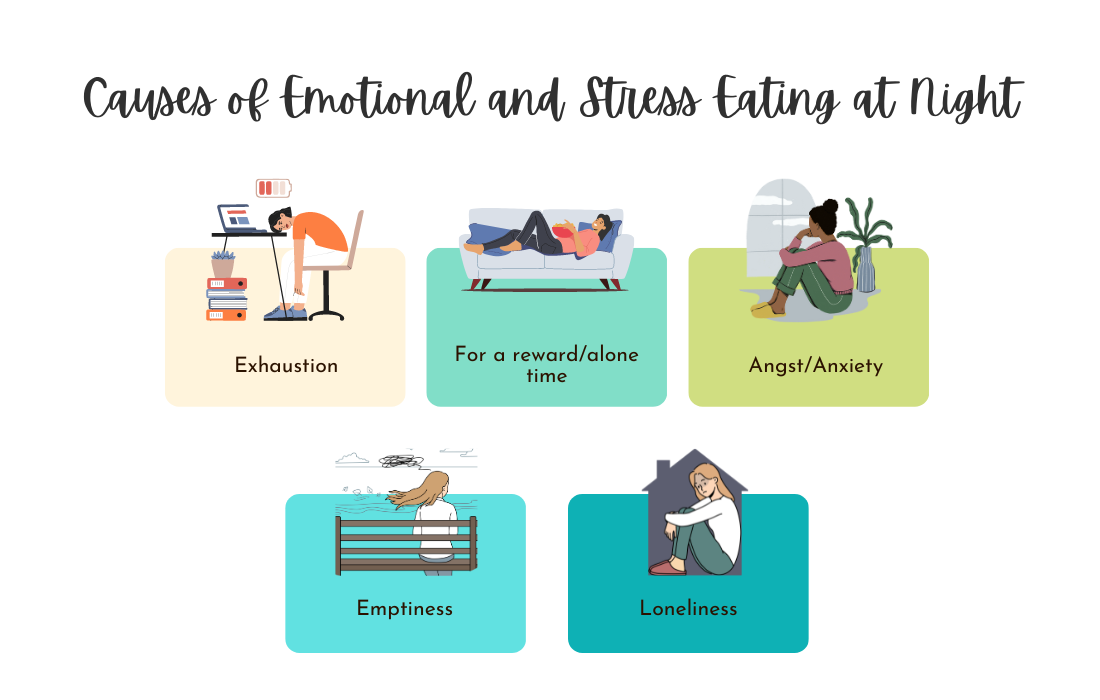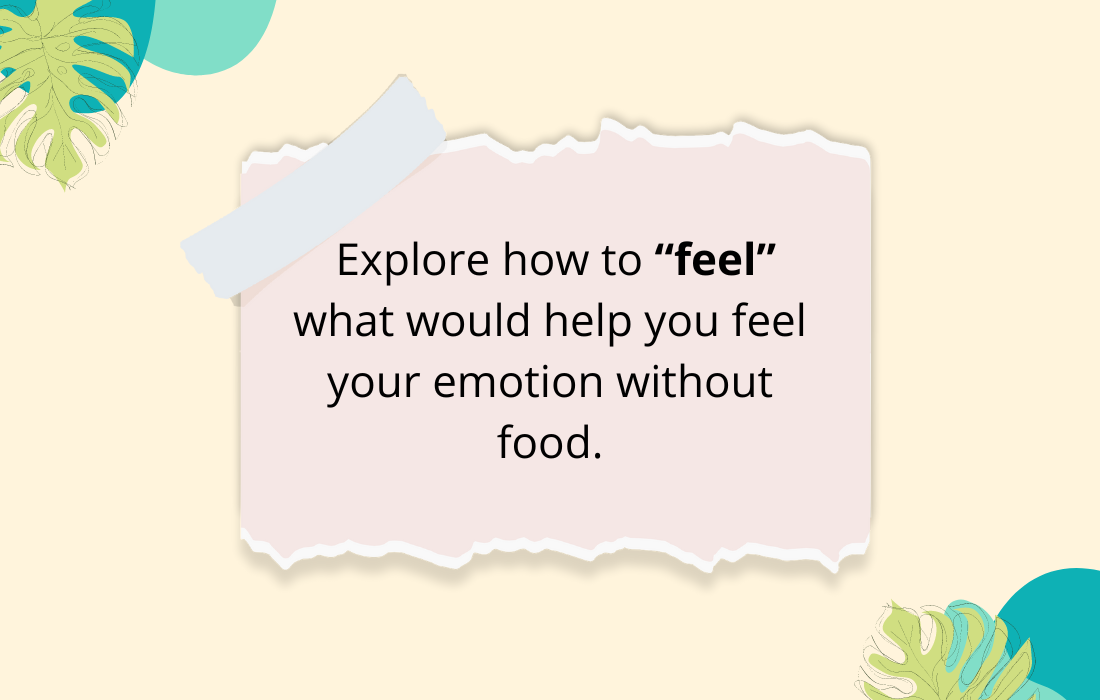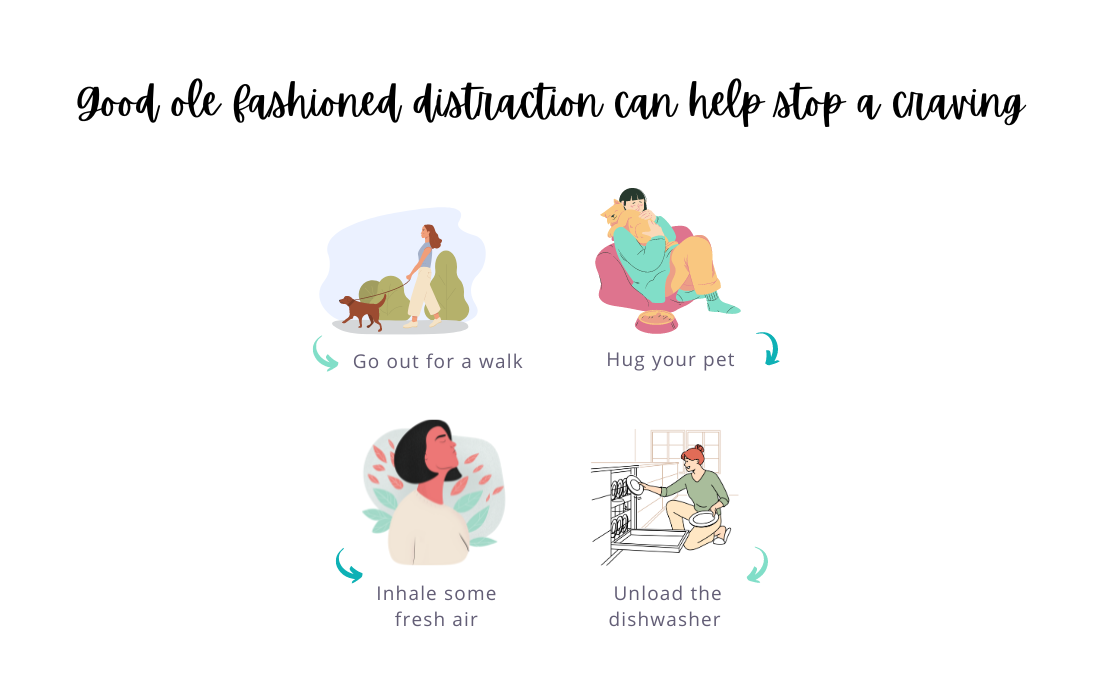Written by Jenn Hand, Holistic Nutritionist, Board Certified Health Coach, NBC-HWC
What Causes Emotional Overeating?
Emotional eating is something we do to dull a painful feeling, escape from life, comfort ourselves, or distract ourselves from something we don’t know how to feel.
Typically, those of us who turn to food emotionally learned this as a coping mechanism for challenging feelings as we grew up. We don’t learn how to deal with anxiety, fear, uncertainty, anger, disappointment, or (insert 100 other emotions here), and food became the way in which we got through them. We can continue this pattern as adults.
Often times, big changes can send us to food: moving cities, leaving for college, starting a new job, getting married, having a child, getting divorced, the death of a loved one, etc. These are big transitions that can bring up a ton of emotions that are challenging to deal with.
But the smaller “life things” can also cause us to overeat: feeling unappreciated by a partner, a comment your boss makes to you, a photo that triggers you on social media, an unexpected bill, or the million other curveballs that life seems to throw our way.
Table of Contents
- Emotional Eating vs Stress Eating: Are They the Same?
- Why Restrictive Food Rules Don’t Typically Solve Emotional Eating
- The Emotional Eating Cycle
- Emotional vs. Physical Hunger
- Causes of Emotional and Stress Eating at Night
- Causes of Binge Eating at Night
- How to Stop Emotional Eating and Stress Eating
- Emotional Eating Won’t Fill the Void
- Should You Work with an Emotional Eating Coach?
- Common Questions about How to Stop Emotional Eating
Emotional Eating vs Stress Eating: Are They the Same?
Stress eating can be a part of emotional eating, and is one of the most commons reasons people turn to food.
Stress isn’t technically an emotion, but the root of stress is something emotional. We can be stressed from all sorts of things (work, family, time, finances, relationships, etc), but underneath the stress is typically some “feeling” that then sends us to the food.
Although stress eating can be a milder form of emotional eating, they are very similar. If emotional eating is the bigger umbrella, stress eating falls under that as something emotional that causes us to turn to food.
Why Restrictive Food Rules Don’t Typically Solve Emotional Eating
When we feel out of control around eating, our default can be to put more guardrails in place to help us get back on track.
This makes sense in our minds, as we’ve felt most “in control” when we were able to stick to a diet. But restrictive rules can backfire and actually make us eat more! I often talk about the diet pendulum, where the willpower we use to keep ourselves on one side (restriction or trying to be “really good”) inevitably then swings to the other side (the “screw it”, I’ll eat what I want mentality).
We may think food rules will keep us in check or give us control, but in reality, it usually only lasts for a very short window before we end up overeating.
Notice if you feel yourself wanting to “reign it in” when you’ve emotionally eaten; it’s a very natural reaction since we don’t like how we feel after overeating. See if you can use that awareness to instead prompt you to ask how to take care of yourself in a more nourishing, holistic way to bring you back into balance.
This will help avoid being stuck in the “restrict then overeat” cycle.

The Emotional Eating Cycle
For many years, the emotional eating cycle was a familiar one for me.
Here’s what would happen:
Trigger/emotion: Someone or something would trigger me, and I’d feel a big emotion. At first, this was unconscious (the trigger led to the food so quickly that I couldn’t separate the pattern I was engaging in.) It could be something as little as a family member making a passive-aggressive comment to as big as a breakup with a significant other or the loss of a job.
Turn to Food: I didn’t know how to (yet) handle emotions, so I would seek out something to comfort me or distract me. Food was always there and provided a focus and a distraction. I’d eat to numb, zone out, forget and/or comfort myself. More often than not, we turn to foods that are sweet, comforting and sugary.
The Illusion of a Problem Solved: The “false bliss” of food coming to the rescue and solving our problems is extremely short-lived. It may only be seconds or minutes while we are eating the food. But we cling to those seconds like a lifeline; food seems to stop time, it gives us the illusion that our problem has gone away. We hope that food will take away what we don’t know how (or don’t want to) feel.
The “After Effects”: This is the familiar feeling of blame, self-hatred, loathing and anger. I experienced this often. After I began to identify my patterns and habits (and where I was emotionally eating), I would get angry and berate myself for being a failure when I couldn’t stop turning to food. This can be the “food coma hangover,” where you feel awful about yourself after you eat.
Emotional vs. Physical Hunger
When we’re working to heal from years spent in the diet cycle, it can be challenging to differentiate between emotional and physical hunger.
When I was beginning to eat more “normally,” I struggled with emotional hunger. I was able to tell the difference, but I battled saying “no” when I had an emotion I wanted to eat over.
Physical hunger is very primal and energy-based.
It’s a signal from our body that we need fuel; it may be a sensation in the stomach (a rumbling, gnawing or emptiness felt in the belly) or lightheadedness or dizziness if it goes past the point of gentle physical hunger. Different people feel this differently and once we start paying attention, the body will make it clear what signals she gives when the body needs fuel. This sensation usually develops slowly over time; physical hunger is gradual.
Emotional hunger, on the other hand, is a response to feeling something.
It may come on suddenly–a craving seems to hit out of nowhere or you suddenly “need” that cookie. It typically is a desire for a certain type of food caused by an emotion. We usually associate “negative” emotions with emotional hunger (like stress, boredom, loneliness, sadness, anger) but positive emotions can also trigger emotional hunger (like joy, happiness, celebration).
One of the differentiators between physical and emotional hunger is how you feel eating.
Physical hunger goes away after eating. Meanwhile emotional hunger can still be there. A craving for a brownie due to boredom doesn’t actually “solve” the issue of being bored. You may eat the brownie and still want more, since emotional hunger needs to be satisfied by addressing the actual feeling.

Causes of Emotional and Stress Eating at Night
In my 9 years of working with women to overcome emotional eating and recover from binge eating, here are some of the bigger (and smaller) reasons I’ve found for emotional and stress eating at night:
- Exhaustion: the stress of working, managing a household, raising children, cooking and house chores, and all the life to-do’s lead to overwhelm and fatigue
- For a reward/alone time: food becomes a small pleasure in a long day of endless responsibilities and as a reward for another day survived
- Resentment at a significant other: there is pent up resentment for the feeling of doing “everything,” and food becomes an outlet for this feeling
- Angst/Anxiety: There can be an underlying sense of low-level anxiety or angst (a feeling of something being wrong but not being able to pinpoint it) and eating is a distraction from this
- Emptiness: When we feel unsatisfied with life and a lack of connection/fulfillment from within, some use food as a way to “fill” what we deeply desire
- Loneliness: In this world of ever-connected tech, we can actually feel more lonely than ever. We crave deep, authentic connection with humans and when this is missing, we can turn to food as a reprieve

Causes of Binge Eating at Night
While emotional eating and binge eating can be caused by some of the same things, there are some other factors that lead to overeating at night that are not due to emotions:
- Not eating enough: Sometimes, when we get in the “I have to be really good,” this can backfire later on at night and cause us to overeat
- Inadequate protein intake: When we don’t have enough protein, it can lead to cravings and physical hunger later in the day (which is hard to willpower through since it’s a physiological need from our body!)
- Going too long without eating: Often, if we’re trying to go long stretches between our meals or snacks, this ends up making us ravenous once the daily activities and busy-ness is done
- Following too many “rules”: if our day is filled with strict guidelines to adhere to certain rules, it can lead to a build-up of “pressure” (it’s like being on a tightrope–lots of stress!). The release of pressure can be food.
- Lack of satisfaction: one of the main factors of a sustainable way of eating long-term is being satisfied with what we are eating. If we aren’t eating foods we enjoy and find satisfying, it can cause the rebellion at night.

How to Stop Emotional Eating and Stress Eating
20 Ways to Stop the Cycle of Stress Eating
1. Identify Emotional Eating Triggers
Certain people, situations or comments may send you to the food. See if you can identify who or what makes you want to eat so you can create a plan to avoid or work through the trigger!
2. Address the Root Cause of Emotional Eating
Typically we use food for a reason. It’s a coping mechanism we learned to help us move through hard feelings. Identify the feeling that causes you to eat (the most common ones: boredom, stress, overwhelm, anger, loneliness)

3. Keep an Emotional Eating Diary
It can be hugely helpful to journal to help you keep track of your triggers. I recommend writing down the time you ate, who/what caused you to eat and what emotion you were feeling at the time.
4. Reflect on Why You’re Eating
In your journal or by yourself, explore what it is you’re hoping the food will do for you. Are you wanting it to comfort you? Fill an emptiness? Give you something to look forward to?

5. Get (More) Comfortable with Discomfort
Feeling emotions can be summed up in one word: uncomfortable. When we’re not used to sitting with sadness, boredom, anger or loneliness to then figure out “how” to process it, it is hard! See where you can expand your ability to be in that discomfort–it’s not good or bad, it just is you experiencing a feeling. 🙂
6. Find Alternative Ways to Cope
A part of letting go of emotional eating is getting those needs met in other ways. If you’re wanting comfort, what else brings you comfort? If you’re alleviating overwhelm, how else can you get support? Alongside this exploration, it can also be helpful to explore how to “feel”–what would help you feel your emotion without food.

7. Pause and Check-In With Yourself During Cravings
One of the things I learned in Overeaters Anonymous was this acronym called HALT. (Hungry Angry Lonely Tired). It was meant to HALT a craving in its tracks–to check in to see if you were actually hungry or really angry, lonely or tired (or any other emotion!) The idea was only to eat if you were physically hungry.
8. Take a Break Before Indulging in a Craving
Sometimes a good ole fashioned distraction can help stop a craving: go out for a walk, inhale some fresh air, hug your pet, clean out a drawer, unload the dishwasher or do something else as a 5-10 minute break.

9. Accepting All Feelings, Including the “Bad” Ones
Our minds convince ourselves that we should only feel the “good” feelings. We are taught to run from the negative emotions, as they are very uncomfortable. But as a human, we will experience a spectrum of emotions throughout our lives. See if you can lean in to all experiences of emotions, and not label them good or bad, but just an experience!
10. Engage in Physical Activity
One thing that helps me get an intense emotion “out” is physical activity. Whether it’s yoga and breathing, a walk or run, a Zumba class or Pickleball, experiment with moving your body as a means to dissipate the energy of the emotional buildup.

11. Talk It Out or Get Emotional Support
Sometimes we just need another person to acknowledge our feelings; we want to express an emotion and need someone to hear us. Call a friend, book an appointment with a therapist or coach, or vent to your loyal pet. 🙂
12. Swapping “Unhealthy” Snacks
This may work for “less” intense emotions rather than a big emotion. If you can’t seem to not eat over the feeling, see if you can swap something more nutritious. (Ideas: popcorn, peanut butter on a chocolate rice cake, decaf latte, Greek yogurt popsicles)

13. Choosing Stress-Fighting Foods
Sometimes we turn to food for comfort. But did you know that some “comfort” foods actually help fight stress?! Experiment with herbal teas, avocado, warm milk, nuts and even dark chocolate, which can all help with stress!
14. Creating Emergency Packages
I used to have an “emotional eating toolkit” for when I needed a quick reference on what to “do” when I was working to not emotionally eat. In it was a journal + pen, lavender essential oil, a stress ball, a coloring book and a list of songs I loved for different moods. Create an emergency “toolkit” to help you know what to do when a challenging emotion arises!

15. Practice Mindful Eating and Savor the Flavors
If you’re going to eat emotionally, see if you can sit down, put it on a plate, really taste the flavors, and enjoy the heck out of it! When you can allow yourself to really BE in the experience, you usually eat much less of the food.
16. Eat What You Really, Really, Really Want
One helpful note is to be sure to eat what you’re REALLY wanting during the day. If you do have a difficult emotion arise and have been restricting or following a lot of food rules during the day, it can be much harder to make a conscious decision to not choose food.

17. Get Support from an Emotional Eating Coach or Therapist
If you feel like you need extra support to work through your emotions, consider getting 1:1 support to help you make progress faster and for the long haul. When you work with an emotional eating coach, you’re no longer alone in the struggle.
18. Stay Hydrated
The age-old “stay hydrated” advice is cliché but true. Check-in on your water intake to see if you need to increase your hydration during the day — also try sparkling water, lemon water, or tea if you don’t like plain water.

19. Get Enough Sleep
Remember the HALT acronym from above? Sometimes emotional eating can happen because we are just really exhausted! See if you can create a routine around bedtime to be sure you’re getting enough sleep for your body.
20. Emotional Eat Consciously, aka. Notice What’s Happening
Awareness can halt overeating in its tracks! If you are conscious when you’re eating (paying attention to what you’re actually doing and the habit that is playing itself out), it can stop a spiral into endless eating. Awareness and overeating can’t exist at the same time 🙂

Bonus Tip: Make Sure You Get Enough Protein!
Protein is key to helping you feel balanced and satiated during the day. Having enough protein actually cuts down on sugar cravings, too so take a look at how much you’re getting (aim for at least 12-20 grams of protein per meal/snack).
Emotional Eating Won’t Fill the Void
One hard lesson I’ve learned over the years is that food doesn’t REALLY do what we want it to do.
When we’re knee-deep in a challenging situation or emotion, eating seems to stop time and give us comfort. It creates the illusion of our “problem” going away. But the reality is, once we’re done eating, we’re now left with two problems:
The shame, guilt and frustration of eating and the problem that we thought would go away with the food.
When I started working through emotions and trying not to eat over them, I also worked through massive disappointment that food didn’t fill the void inside of me.
Realizing I had to learn to deal with LIFE instead of using food was a startling and challenging realization.
I WANTED ice cream to take away the pain, soothe my stress, and make me forget about the emptiness inside of me or the emotion I didn’t want to deal with. But it never did (well, maybe it did for the .05 seconds I was swallowing the bite). After, all I ever felt was guilt, remorse, self-hatred and sadness.
Although this is a hard truth to confront, it can be a huge turning point.
Understanding that food doesn’t truly do what we hope it will can lead to breakthroughs, shifts and habits falling away. Once you come face to face with the void or the feeling, you can learn to move through it and face it head on. 🙂
Should You Work with an Emotional Eating Coach?
Working with someone to help you learn how to stop emotional eating depends on how much you struggle with it.
Some women feel like it may only be a “mild” issue, and they have success with books, self-paced programs, journaling, meditation and other tools to help express emotions.
Other women find they need more help, especially if they’ve grown up without learning how to feel feelings. (Many of us didn’t!).
If you’ve spent years stuffing emotions inside and are uncertain how to actually “feel” a feeling, it may be valuable to get support to help you learn how to do this.
Common Questions about How to Stop Emotional Eating
What if I’m afraid to feel a feeling?
It can be terrifying to feel an intense emotion if you’ve spent years (or even decades) NOT feeling it.
It’s a valid fear; it’s like the scary monster under the bed when we’re little. But I like to think that the more we don’t feel, the scarier it gets (just like the monster, imagining it’s there and then looking under the bed to find it wasn’t as scary as we thought. We don’t need to feel everything at once.
It can be helpful to start small; maybe begin with irritation (vs something like grief or anger or deep loneliness). It’s dipping your toe in the baby pool–just test it out, see what it feels like to feel rather than eat. The fear may still be there, you are just moving forward with courage despite the fear.
How do I actually feel something instead of eating over it?
This is the million-dollar question!
There are tons of tools out there, so it may take some time to experiment to find what works for different emotions and in different situations. My favorite tools are journaling, EFT (tapping), meditation, moving energy (physical movement, tears, yoga, breathwork) and emotional expression.
There isn’t a specific checklist (I know, I wish there was a formula to follow!), but my emotion expression usually begins with journaling.
I write out what I’m feeling and why (using journal prompts or just “What do I not want to feel right now?”). Then I reflect to see if I need to express it to someone or it just needed to be let out in a journal
How long will it take to stop emotionally eating?
If you’ve spent decades or years using food to deal with emotions, it’s not an overnight fix.
I like to think of the healing process as an onion with lots of layers! You can make progress and let go of food at first for less intense emotions and then progress to some of the more challenging ones. It’s a process of lots of small steps over time that add up to big changes!
What if I know what to do instead of eat, but can’t seem to make it happen?
Sometimes we can “know” something intellectually, but it doesn’t always translate into reality.
That’s because we’re only human with complex emotions. 🙂 I like to recommend practicing on very small emotions first. Maybe it’s irritation or light stress. Or even boredom. Find something that seems more doable to explore to help you experiment with sitting through discomfort and getting through an emotion.
More Articles About Holistic Weight Loss and Intuitive Eating
⚪ How to Get Off the Diet Roller Coaster
⚪ 7 Myths of Weight Loss
⚪ If You’re Not Dieting, How Will You Lose Weight?
⚪ Holistic Weight Loss: Does It ACTUALLY Work?
Get the Normal Eater’s Newsletter
Join 8000+ women who are overcoming overeating, binge eating, and breaking up with dieting forever. Get Jenn’s inspiring and actionable weekly newsletter with the latest posts, podcasts, and tips on how to love your body, find food freedom, and lose weight holistically.
Get the Normal Eater’s NewsletterWork with an Emotional Eating & Holistic Nutrition Coach
Overcome Bingeing and Emotional Eating, and Break Up with Yo-yo Dieting
Working with an emotional eating coach and holistic nutritionist can help you get free from the frustrating binge and restrict cycle and stop yo-yo dieting.
You don’t have to be obsessed with food or have a million rules around eating to find your natural weight and learn to love your body. Ready to actually see a lasting change and experience true freedom?
Schedule a 20-min CallAbout the Author:
Jenn Hand has been helping women like you become normal eaters since 2015.
She’s worked with thousands of women, helping them to balance their bodies, end bingeing, stop obsessing over food, and start feeling amazing again. As a board-certified health coach and holistic nutritionist, Jenn knows how to support you in making real positive changes that last.
Her articles have been published on Mind Body Green, Tiny Buddha, Thrive Global and other local and global media platforms. She’s the author of How to Be a Normal Eater and the creator of The Normal Eater’s Club program. Listen to Jenn’s advice and tips on the Cake Doesn’t Count Podcast, or read more of her articles for free on the Food Freedom Blog.
Learn About Coaching!




